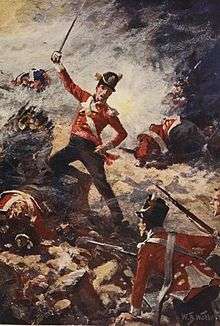Forlorn hope

| Look up forlorn hope in Wiktionary, the free dictionary. |
A forlorn hope is a band of soldiers or other combatants chosen to take the leading part in a military operation, such as an assault on a defended position, where the risk of casualties is high.[1]
Such a band is also known as the "enfants perdus" (lit. "Lost Children").[2]
Etymology
The term comes from the Dutch verloren hoop, literally "lost hope". The term was used in military contexts to denote a troop formation.[3][4][5][6]
The Dutch word hoop (in its sense of heap in English) is not cognate with English hope: this is an example of false folk etymology.[7][8][9] The mistranslation of verloren hoop as "forlorn hope" is "a quaint misunderstanding" using the nearest-sounding English words.[10] This false etymology is further entrenched by the fact that in Dutch the word hoop is a homograph meaning "hope" as well as "heap", though the two senses have different etymologies.
History
In the German mercenary armies of the Landsknechts, these troops were called the Verlorene Haufen, which has the same meaning as the Dutch term, the word Haufen itself being a general term for a loosely organised group of men. These men carried long double-handed swords, with which they had to hew their way through the massive pike formations opposing them. They also had to withstand the first wave of attacks when defending a breastwork. Members of the Verlorene Haufen earned double pay, thus giving them the name of Doppelsöldner ('Double-wagers'), but since there were not enough volunteers, criminals that had been sentenced to death were taken into the ranks as well. As a field sign, the Verlorene Haufen carried a red Blutfahne ('Blood Banner').
By extension, the term forlorn hope became used for any body of troops placed in a hazardous position, e.g., an exposed outpost, or the defenders of an outwork in advance of the main defensive position.[1] This usage was especially common in accounts of the English Civil War, as well as in the British Army in the Peninsular War of 1808–1814. In the days of muzzle-loading muskets, the term was most frequently used to refer to the first wave of soldiers attacking a breach in defenses during a siege.
While it was likely that most members of the forlorn hope would be killed or wounded, the intention was that some would survive long enough to seize a foothold that could be reinforced, or, at least, that a second wave with better prospects could be sent in while the defenders were reloading or engaged in mopping up the remnants of the first wave.[1] That said, such soldiers were rarely suicidal or foolhardy: British troops of the forlorn hope at the 1812 Siege of Badajoz carried a large bag (5–6 feet (1.5–1.8 m) by 2 feet (0.61 m) in diameter) stuffed with hay or straw, which was thrown down into the enemy trenches to create a cushion and prevent injury as they jumped down.[11][6]
A forlorn hope may have been composed of volunteers and conscripted criminals, and were frequently led by ambitious junior officers with hopes of personal advancement: if the volunteers survived, and performed courageously, they would be expected to benefit in the form of promotions, cash gifts, and added glory to their name (a military tradition at least as old as the Roman Republic[12]), while the commanding officer himself was virtually guaranteed both a promotion and a long-term boost to his career prospects.[13]
In consequence, despite the grave risks involved for all concerned, there was often serious competition for the opportunity to lead such an assault and to display conspicuous valor.
The French equivalent of the forlorn hope, called Les Enfants Perdus ('The Lost Children'), were all guaranteed promotion to officer rank should they survive, with the effect that both enlisted men and officers joined the dangerous mission as an opportunity to raise themselves in the army.
See also
References
- 1 2 3

- ↑ "enfants perdus", Merriam-Webster.com
- ↑ Oxford English Dictionary: "forlorn hope"
- ↑ Kilian, Cornelius (1593). Etymologicum Teutonicæ Linguæ. Antwerp: Jan Moretus (cited in Oxford English Dictionary).
- ↑ Merriam Webster entry: 'forlorn hope' Archived 2007-10-11 at the Wayback Machine.
- 1 2 "'Never Trump' Republicans could have their revenge". The Economist. 9 August 2018. Retrieved 15 August 2018.
- ↑ Newman, John B (1984). Raphael, Lawrence J; Raphael, Carolyn B; Valdodinos, Miriam R, eds. Language and Cognition: Essays in Honor of Arthur J. Bronstein. New York: Plenum Press. pp. 203–4. ISBN 0-306-41433-3.
- ↑ Todd, Loreto; Hancock, Ian (1990). International English Usage. London: Routledge. p. 233. ISBN 0-415-05102-9.
- ↑ Attridge, Derek (1988). Peculiar Language: Literature as Difference from the Renaissance to James Joyce. Ithaca, New York: Cornell University Press. p. 112. ISBN 0-415-34057-8.
the Dutch phrase verloren hoop, the "lost heap"…became naturalized—and generalized—as forlorn hope...a quaint misunderstanding [from] folk etymology.
- ↑ "The American Heritage Dictionary of the English Language". Bartleby. 2000. Archived from the original on March 6, 2009. Retrieved 18 July 2011.
- ↑ The London Journal, and Weekly Record of Literature, Science, and Art. G. Vickers. 1847. p. 155.
- ↑ Crowns were bestowed after a Roman triumph by generals to soldiers who won personal victories in battle... [such as being] first to scale a wall. Dio Cassius: Roman History 6.21
- ↑ Bertaud, Jean-Paul (1988). The Army of the French Revolution: From Citizen-soldier to Instrument of Power. Princeton University Press. pp. 23–37.